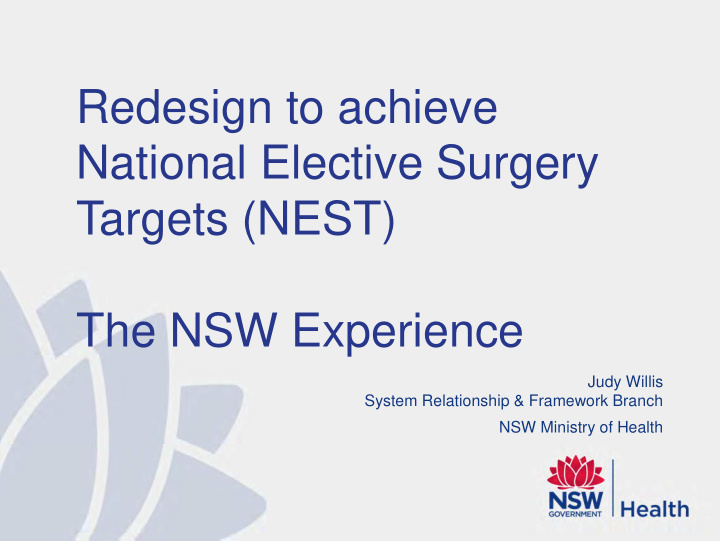



Redesign to achieve National Elective Surgery Targets (NEST) The NSW Experience Judy Willis System Relationship & Framework Branch NSW Ministry of Health
Overview The NSW Strategy for NEST Booking Office & Waiting List Management Pre Admission processes Operating Theatre Efficiency Models of Care – High Volume Short Stay – Specialist centres – Emergency Surgery Other initiatives
National Elective Surgery Targets (NEST) - NSW Part 1: Stepped improvement in the number of patients treated within the clinically recommended time . Time Cat 1 % Cat 2 % Cat 3 % Baseline 92.3 86.6 89.4 By Dec 2012 96 90 92 By Dec 2013 100 93 95 By Dec 2014 100 97 97 By Dec 2015 100 100 100 YTD Cat 1% Cat 2% Cat 3% Sept 2012 94.6 90 92.2
NEST Part 2 – Reduction in Long Waits Part 2: A progressive reduction in the number of patients who are overdue for surgery, particularly patients who have waited the longest beyond the clinically recommended time. AV Days waited above the urgency category timeframe on 31/12/12 Cat 31/12/11 31/12/12 31/12/13 31/12/14 31/12/15 1 0 0 2 39 29 20 10 0 Zero Cat 1 3 130 98 65 33 0 overdues Av wait over benchmark no more than 29 days
NEST – Things to consider The more overdue patients you treat = less percentage treated on time (calculated when patients are admitted) A few months of poor performance can mean you never make the Part 1 target all year. Consistent performance is a must... Having no overdue patients at the end of the month doesn’t mean you will make NEST Part 1 1 day overdue is as bad as 10 days or 50 days overdue in Part 1 but to meet Part 2 average no. days over needs to be less that average target days on 31/12 each year
$209.2M from the National Elective Surgery Target (NEST) Facilitation & Reward Funding Year Facilitation Reward (part Reward (part 1) 2) If you don’t meet the target for a 2010/11 $114.9M - - period the reward repayment gets added to the next 2011/12 $31.1M - - period, although can’t roll over the last year 2012/13 - $7.9M $7.9M 2013/14 - $7.9M $7.9M 2014/15 - $7.9M $7.9M 2015/16 - $7.9M $7.9M TOTAL $146M $31.6M $31.6M *National Partnership Agreement (NPA) on Improving Public Hospital Services, pg 17 & 29 http://www.coag.gov.au/docs/nap_improving_public_hospital_services.pdf
NEST Strategies
NSW Strategy Booking Office and Pre Admission Admission Process NEST Models of Care & Operating Theatre Discharge Efficiency Processes
Booking Office & Waiting List Management Clear policy and business rules RFA Management – Appropriate CPC – Treat in turn Escalation Systems Staff Training Program Documentation & Record keeping Communication (internal with other departments) Communication (external with VMOs & patients) Auditing Systems
Admission Procedures Staggered Admission times Day of Surgery Admissions maximised Short stay surgery maximised Utilise High Volume Short Stay Surgical principles Established process for direct surgical admission
Pre-Admission Assessment Pre-Admission All Patients complete a Patient Health questionnaire (PHQ) All PHQs are screened and triaged for PAC Anaesthetic support for PAC Available PAC places to meet demand Patient expectations – Process knowledge – Expected LOS
Operating Theatre Suite & PARU Peri operative Processes Leadership Operating Theatre/Room efficiency & safety 1 st case on time starts Turnover time Time Out Equipment/radiology/pathology Cancellations on Day of Surgery minimised Capacity Planning – weekly review of advance operating theatre lists Utilisation of technology - RFID
First Case on time Start Projects
Models of Care Recommended from Surgery Futures Project (2010) High Volume Short Stay surgery Specialist Centres Emergency Surgery
HVSSS Model • High Volume Short Stay Surgery (HVSSS) is defined as planned surgery/procedures requiring admission for up to 72 hours. It includes both Day only and Extended Day Only Surgery • Builds on the established Extended Day Only Model
Specialty Centres Specialist surgery met through development of formal specialist centres with: • Clearly delineated referral roles within a geographic region • Clinical and research leadership provided throughout the catchment • Operates within a network of services • Provides access to a high level of expertise • Concentrating high cost resources such as highly complex interventional radiology and other medical imaging and surgical support services
Emergency Surgery Standard-hours scheduling where clinically appropriate; Load balancing of standard-hours operating theatre sessions with emergency surgery demand; Streaming of elective and emergency surgery in hospitals; Reallocation of surgery resources appropriate to roles of the designated hospitals; Safe interhospital transfer processes; and Specific emergency surgery KPIs
Embedding the new models Funding to establish model with a requirement to provide regular progress reports Surgery Redesign Training Program for project leads LHD Performance framework
Surgery Redesign Training Program Aims To give project leads the skills & knowledge to successfully implement the model or initiative Network with other project leaders who are implementing same or other models (emergency surgery & specialist Centres) Cement an ongoing relationship between the Ministry and Project leads Have a project plan completed by the end of the 5 day course.
Surgery Redesign Training Program 31 participants have completed (Nov 11 & May 12) Another 20 staff to undertake program in Dec 2012 Topics: Patient flow, Handover, Business case writing, Understanding data, clinical protocol development Project management skills (1 day- Fundamentals of project management) Implementation skills (2 day Accelerated Implementation Methodology Training) – a methodology which focuses on the human elements of change
Other initiatives NSW Surgical Services Taskforce sponsorship – Reward payments for performing hospitals (COAG funds) Monthly Surgery Manager Teleconferences LHD Self Assessment Checklist Site Visits Articles in the Surgery News (bimonthly newsletter)
Goal To ensure all Elective Surgery patients are treated within the recommended timeframe Improve our processes & practices to: – reduce delays & cancellations – Improve efficiency – Improve patient experience
The Surgery Program Preadmission Bookings & Admission Peri operative Post op care & Discharge Processes
Further information ARCHI http://www.archi.net.au/resources/delivery/surgery/predictable- surgery/7 National Health Reform http://www.yourhealth.gov.au/internet/yourhealth/publishing.nsf/ Content/npa-improvingpublichospitals-agreement- toc~schedule-a Ministry Contacts Judy Willis juwil@doh.health.nsw.gov.au
Recommend
More recommend